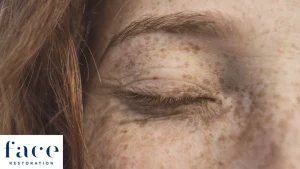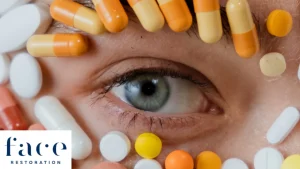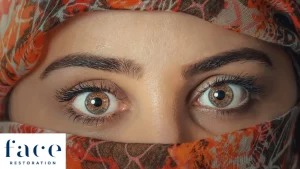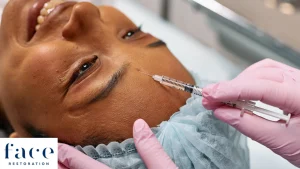Video Transcript
Intro
Sarah: Hi guys, welcome back to the channel! I’ve got something rather special for you coming up over the next few weeks. I’m going to be sat here with a couple of oculoplastic surgeons. We’ve got Rachna and Jonathan here from Face Restoration and we’re going to be talking about a wide variety of different things all to do with the eyes. I don’t know how many we’re filming because we’re just riffing it as we go along but hopefully, you will enjoy the series.
Causes
Sarah: Let’s take it away first of all by talking about dark circles underneath the eye and how you would fix them as surgeons. What’s the cause?
Rachna: There are lots of things that can cause it. This is the area where our skin is really really thin so it’s the thinnest skin in the whole body, less than half a millimeter in terms of thickness. The skin covers lots of little blood vessels and those blood vessels you can see quite easily underneath the skin. Particularly when you have fair skin, you can see blood vessels underneath and so that can give the impression of darkness.
Jonathan: If you have a weakening of something called the septum which attaches the lid to this bone, you can get fat pulling forward and we tend to see this as you get older. And that can then, in a certain light, you can create a shadow and so sometimes the dark circle isn’t just these blood vessels it’s actually the way the light shines on the face. Then if you can alter the contours either by reducing the bags or filling in the trough, you can again change the appearance. So when you’re younger, we have these nice puffy little cheeks and they sit up quite high. As we age when we get dehydrated, things move down, and that then stretches that skin.
Sarah: Sounds grim. What about in a patient who’s 20 and they’ve got dark circles?
Jonathan: The sorts of things we can do then is try to plump things up. We can try to lift these tissues up a little bit either surgically or non-surgically, we can try to make the skin a little bit more full or hydrated again with the fillers that you use.
Rachna: But a lot of people do have pigmentation in their skin as well, so that’s a very common cause for dark circles.
Filler
Sarah: Okay, so you just mentioned that you’re using filler around the eye do you guys have a preference?
Rachna: The Juvederm range of products. So I would use something like Volite in the skin.
Jonathan: When you’re lifting the heavy tissues you want a molecule or a product that’s going to be long-lasting and has lifting power. So for that, we would use something like Voluma for example.
Sarah: I use a lot of Teosyal Redensity 2 under the eye. Keith uses a lot of Restylane Vital Light.
Rachna: We use a combination of Voluma Volift and Volite to treat the eye bag area. But if you’re going to use something that lifts in the eye area where you’ve got very thin skin, it can give you a very nasty look where you can sometimes see it in some people who have had these treatments the appearances of these blue pools of filler sitting in the eye bag area. And that’s called the Tyndall effect. So when we look at the sky, the sky looks blue because the light is split and we see the blue light come through. And the same thing happens when you put a big blob of filler, the wrong filler in the teardrop area and it looks very blue.
Jonathan: This area is covered with blood vessels and they’re slightly unusual blood vessels because they connect to each other. You can go from one artery into another with a product and that can be very dangerous.
Surgical
Sarah: Okay, so how would you do it surgically?
Jonathan: You can fill with fat, you can reposition fat from the area around the eyeball or you can lift fat from the face and I think that summarizes the different surgical approaches. What some of us like to do is to actually take fat from another part of the body, sometimes from under here or from a thigh or an abdomen, spin it down, get the fat, and then re-inject it into different places. And that can have a nice looking effect and it can plump up and it can be long-lasting but there are a few downsides. One is that it’s got a higher risk of embolism and you can’t dissolve it. If you’ve got fat flying around the circulation there’s not much you can do about that.
The other thing is sometimes these fat transfers can end up looking a bit lumpy rather than getting a nice smooth area. And sometimes afterwards they can grow because these are living cells that you’re repositioning. So if you gain weight somewhere you might gain weight there.
Rachna: You don’t want to gain a lot of weight.
Jonathan: Sometimes these cells die, so you put in a certain amount and then you end up getting less of an effect than you thought. And sometimes these cells do very well and they grow and you end up having more of an effect. What’s nice about the hyaluronic acid filler is that it’s very precise. Fat transfer is good because it lasts forever potentially and it can have a very nice effect on the skin as well but it is more dangerous and it’s less predictable.
Rachna: The fat is now spun down and it’s now more nano fat so the chances of having the little lumps and bumps it’s much less.
Jonathan: You can also reposition fat and what some of us like to do is we like to take fat from just around the eyeball. There’s a little piece of cellophane here we can go in and pull fat out from around the eye and fill in the trough. But the risk of that is that when you do that you could end up with more of a hollow at the top and you can end up having the eyeball look like it’s no longer cushioned in that nice sort of soft fluffy surrounding which makes us look young, youthful. And you can end up looking more skeletized and older.
Non-Surgical
Sarah: I know what they’re going to be thinking at home right now: “Give me something that I can do at home.” So do you have any suggestions?
Rachna: Vitamin C, serums are good for pigmentation in the under-eye area as well as on the skin generally. Then Hydroquinone and then Cyspera. Certainly, you can put hyaluronic acid and plump up the skin as well as a topical.
Sarah: If you’ve got pigmentation underneath the eye you can use something like Cyspera, Hydroquinone which is prescription only. If it’s more of a skin quality issue then you’re looking at using what, vitamin A, hyaluronic acids, peptide acids.
Rachna: Which are also prescription and the peptides you can have it topically. You can also take collagen, you know, by mouth as well as drinks or there are various different brands and products. And so I like the ZENii range and also Skinade as well, you know there’s plenty around which will help to hydrate as well.
Sarah: Top tip from me guys. Cernor XO vitamin K cream for dark circles also works well.
So in terms of things that I also use around the eye non-surgically, would be things like Carboxytherapy but you need a lot of treatments for that to work. Tends to work better in people with darker skin tones. LightEyes which is mesotherapy, is from a company called Promoitalia and works really really well. Sometimes a bit of SuneKOS as well if the skin texture is quite creepy, that’s the SuneKOS 200.





